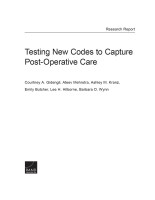| 来源类型 | Research Reports
|
| 规范类型 | 报告
|
| DOI | https://doi.org/10.7249/RR1815
|
| ISBN | 9780833097217
|
| 来源ID | RR-1815-CMS
|
| Testing New Codes to Capture Post-Operative Care |
| Courtney A. Gidengil; Ateev Mehrotra; Ashley Kranz; Emily Butcher; Lee H. Hilborne; Barbara O. Wynn
|
| 发表日期 | 2017
|
| 出版年 | 2017
|
| 页码 | 42
|
| 语种 | 英语
|
| 结论 |
- In interviews, individual physicians were able to apply the proposed G-codes to recent visits and the draft vignettes with reasonable accuracy. However, when we surveyed a larger group of physicians there was a roughly 30–40 percent error rate.
- Accuracy varied widely by the five specialties (cardiology, dermatology, general surgery, neurosurgery, and ophthalmology) in the survey, and the reasons for this are unclear. Each specialty was given a unique and distinct set of vignettes that were tailored to their specialty. Some vignettes may have been easier to code than others, which may explain some of this variation.
- Common concerns with the proposed G-codes emerged, which included the burden of reporting the codes, keeping track of time spent, the definition of "typical" and "complex," and how the codes capture work done by multiple practitioners.
|
| 摘要 |
- The methodology of using vignettes to test new codes could be considered prior to implementing similar codes in the fee schedule. We uncovered a number of questions and errors in both the interviews and the survey. Such input could be used to help refine instructions for practitioners and to potentially refine the codes themselves. This may help improve the overall accuracy of practitioner coding.
- Future work should explore how practitioners who use time-based codes track time, and whether they have difficulty accurately tracking time given that their care may extend over numerous encounters in a day. For example, one point of confusion for practitioners was how to round when using time increments. However, the rounding used for the proposed G-codes mimicked what is used for other time-based codes. Therefore, it is possible that practitioners are also confused by other time-based codes.
- Given the concern that physicians expressed about distinguishing between "typical" and "complex" visits, it may be useful to test whether practitioners are also struggling in deciding on the correct level in terms of complexity of decisionmaking in evaluation and management visits.
- As the larger health care system moves to more team-based care, distinguishing what work should be included when multiple practitioners are providing care will be increasingly important. Therefore, it may be useful to test existing codes for accuracy when care is provided by multiple practitioners.
|
| 主题 | Bundled Payment for Health Services
; Health Care Organization and Administration
; Medicare
; Physicians
|
| URL | https://www.rand.org/pubs/research_reports/RR1815.html
|
| 来源智库 | RAND Corporation (United States)
|
| 引用统计 |
|
| 资源类型 | 智库出版物
|
| 条目标识符 | http://119.78.100.153/handle/2XGU8XDN/108480
|
推荐引用方式
GB/T 7714 |
Courtney A. Gidengil,Ateev Mehrotra,Ashley Kranz,et al. Testing New Codes to Capture Post-Operative Care. 2017.
|
|
文件名:
|
x1495316257653.jpg
|
|
格式:
|
JPEG
|

|
文件名:
|
RAND_RR1815.pdf
|
|
格式:
|
Adobe PDF
|
除非特别说明,本系统中所有内容都受版权保护,并保留所有权利。